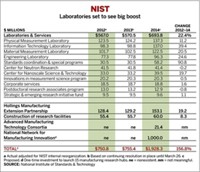Advertisement
Grab your lab coat. Let's get started
Welcome!
Welcome!
Create an account below to get 6 C&EN articles per month, receive newsletters and more - all free.
It seems this is your first time logging in online. Please enter the following information to continue.
As an ACS member you automatically get access to this site. All we need is few more details to create your reading experience.
Not you? Sign in with a different account.
Not you? Sign in with a different account.
ERROR 1
ERROR 1
ERROR 2
ERROR 2
ERROR 2
ERROR 2
ERROR 2
Password and Confirm password must match.
If you have an ACS member number, please enter it here so we can link this account to your membership. (optional)
ERROR 2
ACS values your privacy. By submitting your information, you are gaining access to C&EN and subscribing to our weekly newsletter. We use the information you provide to make your reading experience better, and we will never sell your data to third party members.
Environment
William Jeffrey Talks Shop
NIST's director sees his agency playing a vital role in keeping America competitive
April 2, 2007
| A version of this story appeared in
Volume 85, Issue 14

IT'S HARD TO IMAGINE a time when a gallon in one area of the U.S. did not contain the same amount of liquid as a gallon in another. But when the National Bureau of Standards was founded more than 100 years ago, there were eight different legal definitions of the gallon. Thanks to the work done by NBS, which changed its name to the National Institute of Standards & Technology (NIST) in 1988, there is a single legal definition for a gallon across the U.S.
The standardizing of the gallon is just one everyday example of the role NIST has played in the U.S. economy. In fact, the weights and measures standards set by NIST provide an innovation infrastructure that has allowed the U.S. economy to thrive. Today, NIST is working in areas as diverse as nanotechnology and biomedical imaging to develop standards and improve measurement capabilities both to drive U.S. economic competitiveness and to push the frontiers of science.
It's this combination of innovation and economic impact that has NIST well-positioned to be a leader in the growing movement to increase U.S. global competitiveness. NIST is one of the three key physical science agencies targeted by President George W. Bush's American Competitiveness Initiative (ACI) to double its budget over the next decade.
Ensuring that NIST continues to fulfill its mission, while expanding its efforts under ACI, is agency Director William Jeffrey. Jeffrey became the 13th director of NIST when he took the reins in July 2005. Prior to joining NIST, Jeffrey held positions at the Defense Advanced Research Project Agency (DARPA) and at the Office of Science & Technology Policy (OSTP). He holds a bachelor's degree in physics from Massachusetts Institute of Technology and a Ph.D. in astronomy from Harvard University.
Jeffrey now oversees the $843 million agency, which employs 2,900 people at its Gaithersburg, Md., and Boulder, Colo., campuses. The campuses also host nearly 2,500 associates and facility users from academia and industry who take advantage of NIST's technical expertise and state-of-the-art equipment.
In a recent interview with C&EN Associate Editor Susan R. Morrissey, Jeffrey discussed NIST's current activities and how initiatives like ACI are having an impact on the agency.
With your agency playing such a key role in innovation and competitiveness, are you surprised at how few people seem to know about NIST?
The answer to your question is yes and no. When you deal with the technical community and the science community, almost everyone knows about NIST. Although they probably don't know the breadth of NIST, they know the piece that they interact with. It has a very positive brand recognition and international recognition. It's one of those things that's probably better known internationally than nationally.
But what about those outside the science community?
For policymakers and chief executive officers who are nontechnical, it would be nice for them to understand a little bit more about what NIST does. I've been here now a year-and-a-half, and before my confirmation hearing, I met with a lot of congressional staff and members. They had all heard of NIST and had a very positive feeling about the agency, but often they weren't exactly sure of the details of what NIST does and where it fits in.
What are you doing to increase the awareness of NIST?
One of the things that I am working very consciously on is trying to increase the awareness of what NIST does for the nation to policymakers and to others so that they understand that we do exist and understand the importance and the part we play. They don't need to understand the specifics to a detailed technical level.
I think that there has been a significant improvement in the understanding—not just in the name recognition or the positive feelings about NIST—but really in what we do. I think we are on the right path, and I think the awareness will continue to increase.
One way to do this is by showing how NIST's activities affect the economy. Has NIST done such studies?
Yes, we measure everything, including ourselves. We did 19 different retrospective economical studies over the past decade. We tried to look at the direct economic impact—no multiplier, no secondary effects. In those studies, we generated a 44:1 average benefit-to-cost ratio. We think this is fairly conservative.
The reason that it's so large also gets into the fact that we work at the infrastructural level. When we make an advance in measurements or standards, it's not an advance for an individual company. It's an advance for an entire sector of the economy or an entire industry.
With NIST's mission focused on innovation and competitiveness, it's a natural fit with the President's ACI. How optimistic are you that Congress will follow through with the requested budget increases?
I'm actually very optimistic. One of the things that is really heartening to see is that this issue is bipartisan. Everybody understands the importance of innovation for future U.S. competitiveness. And everyone understands the importance of the physical sciences to innovation. I see representatives from all sides of the issue working very closely together to try to make this a reality.
Why do you think American competitiveness has become an important issue?
When you look at the context that this was put in, it was almost a "perfect storm" of different pieces. You had Tom Friedman's book "The World Is Flat," which I think helped to sensitize a broad sector of the community, as well as policymakers, to the issue. The book put into descriptive language the issue of globalization and competitiveness.
Then you had the National Academies report "Rising above the Gathering Storm," which took those ideas into specific recommendations. This was followed by the President's State of the Union address, which included ACI. This initiative took the debate to another level of specific implementation and budgetary issues and priorities.
It was the confluence of all of these factors, focusing the spotlight on the importance of science, engineering, and education for future American competitiveness. And, quite frankly, we're in a great position to be able to take this on now—the U.S. economy is doing amazingly well. We're not in an era of desperation. We can do this in a methodical way to prepare ourselves for the future and do what's best for our long-term economic security.
Some folks worry that the focus on the physical sciences is coming at the expense of the biomedical sciences. Do you agree?
People should not view this as a competition because the two have a tremendous synergistic relationship. It really is eye-watering when you think of how different our understanding of biology is now than it was 10-15 years ago. Our understanding has completely shifted, and the potential is tremendous. But to really exploit and leverage a lot of the potential, we will need advances in physics, chemistry, and engineering. That's why I think the two areas together are really very powerful.
Can you give an example of how NIST is a part of that synergy?
One of the programs we have in the fiscal 2007 budget is a partnership with the National Institute of Biomedical Imaging & Bioengineering at the National Institutes of Health. It involves taking magnetic resonance imaging of the heart from a functional tool to a quantitative one. Here at NIST we are enabling ways to determine the rate of blood flow through the heart, but we can't interpret what that means in terms of impact to health, diagnosis, treatment—that's where NIBIB comes in. It's a perfect marriage that shows what NIST can bring to the table and what NIH can bring to the table. I see a lot more opportunities like that in the future.
Because of ACI, one of the areas set to see a boost in its fiscal 2008 budget is nanotechnology. Can you talk about NIST's efforts in this area?
Under ACI, we are able to create a Center for Nanoscale Science & Technology at NIST. Our center will work with the Centers of Excellence at the National Science Foundation and the Department of Energy to translate the absolutely exquisite discoveries coming out of the NSF and DOE centers into what industry and academia need to take it to the next level.
To give you an example, take our work on carbon nanotubes. We collected several batches of nanotubes from different manufacturers and characterized them. One of the things we found was that 60% of the atoms by mass in the nanotubes were not carbon. There were a lot of heavy metals that had been used as catalysts in the production. We also found that the batches were not always carbon nanotubes; they were buckyballs or graphite or other things. It makes for a really interesting issue: How do you ensure the quality of the product?
That's a big issue for nanotech right now.
Yes it is. So we started working in this area. We found some very inexpensive, reliable ways of purifying samples to separate the carbon nanotubes from the heavy metals. We are producing a carbon nanotube reference material that hopefully will be available soon. We can then feed the reference material back to the manufacturers so that as the manufacturers produce these things, they can tie their measurements back to NIST for specific quality assurances and processes.
What are some other areas that will benefit from the budget growth?
Quantum science is one big area that will grow because of ACI. The universe acts differently at the atomic scale than it does at the everyday scale. The laws of physics are very different. We're just getting to the point where we are starting to be able to exploit those really bizarre behaviors for everyday use. The quantum world actually opens up the ability for us to push fundamental measurements orders of magnitude better than what we could do with classical measurements. We're interested in this not just in terms of applications but also in terms of it opening up a whole new world of opportunity for pushing basic measurement science.
ACI will also allow us to increase support for our climate-change science program. One of the projects we proposed to work on deals with developing calibration systems and absolute standards for satellites that measure the total amount of energy hitting Earth's atmosphere from the sun. It is important to be able to track small changes in the sun's output over many decades. Tying into an absolute standard that we will develop means that you could then not just compare results among U.S. systems, but you could compare U.S. measurements with those made by European systems, Japanese systems, and others.
The Advanced Technology Program and Manufacturing Extension Program are two popular NIST programs that fund research in the private sector. As it has in the past, the Administration has targeted them to be cut in the 2008 budget. Congress again has pledged to save them. Why does the Administration want to cut them?
The issue is that we operate at this infrastructural level. Our sweet spot is making the technical advancements for standards that affect an entire industry or large sectors in the economy.
Fundamentally, we believe that the advances that we make in measurement science and in standards have a larger, long-term impact on our economic security than when we are working at an individual company level or small consortia of companies level. We have to balance those kinds of priorities because budgets are finite.
So it's a matter of having enough money?
It is a matter of priorities. I believe both programs are well-managed and well-executed. But it is a question as to really whether those are the right priorities in a tight budget environment. I fully recognize and respect Congress' disagreement with the Administration on the priorities. But the one thing that I will absolutely shout out from the mountain tops is that we will continue to execute the programs effectively and efficiently given the enacted budget.
Advertisement
What's the best part of your job?
Honestly, it's the enthusiasm of the staff. This is a great place. We really do have an impact on the economic security of the nation, and the staff understands that.







Join the conversation
Contact the reporter
Submit a Letter to the Editor for publication
Engage with us on Twitter